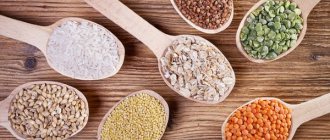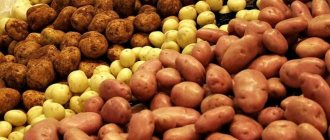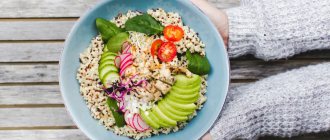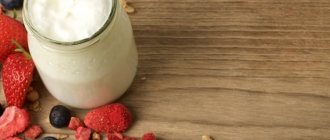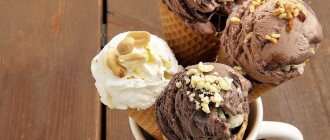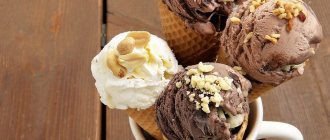Blueberries are the “queen” of northern latitudes. It includes about 100 species of various blueberry bushes and trees. Its distribution area is very wide: it grows in the forest-tundra, taiga, coniferous forests and sphagnum swamps of Europe and Asia, in the Caucasus mountains. The common blueberry, or myrtle-leaved blueberry, is the most common species of this genus. The largest variety of blueberry is a tree growing in the Caucasus mountains - Caucasian blueberry. This tree can reach up to 3 m in height, and its fruits do not have the same coloring properties as blueberries. Blueberries also grow in the forests of North America, but even there they are of Eurasian origin.
What does a common blueberry look like? This is a low-growing shrub that rarely reaches even half a meter in height. The blueberry bush blooms in late May–June, and the fruits ripen by the end of July–August. Its berries are round in shape, up to 8 mm in diameter, and are dark blue with a bluish tinge. The taste of the berries is sweet with pleasant sourness and a slight tartness.
Blueberry jam
A delicious treat - blueberry jam. To make jam, housewives use only 2 ingredients - sugar and berries. Classic recipe: 1 kg of berries, 500 g of sugar, but the ingredients can be taken in other proportions. The calorie content of blueberry jam will depend on this. Its value varies between 205 - 300 kcal per 100 g of product.
On an industrial scale, jam is made from the same basic ingredients, but additionally preservatives, acidity regulators, flavorings, and pectin can be added to the delicacy. This does not significantly affect calorie content, but negatively affects the health benefits of jam.
Read also: Krubera-Voronya Cave in Abkhazia
Blueberries in cosmetology
Blueberries are actively used in cosmetology due to a significant number of beneficial properties and unique composition. In particular, it is worth noting the beneficial effect of the berry on the facial skin of women and girls. Blueberry extract is a popular remedy in both salon and home cosmetology.
As a cosmetic product, blueberries help:
- relieve swelling;
- strengthen blood vessels;
- saturate the skin with vitamins;
- rejuvenate the epidermis;
- smooth out wrinkles;
- get rid of redness caused by exposure to environmental factors, such as dirt, dust, etc.;
- even out your face tone.
A decoction of blueberry leaves and ground berries is an opportunity to really remove dark circles under the eyes.
Blueberry extract will also help cope with acne. This is especially true for teenagers, but blueberries help clear up acne at any age. In addition, the berry perfectly combats dry skin, signs of fatigue and helps even out the complexion.
Varieties and types of berries
This berry crop can be of 2 types: wild forest and garden. Blueberries are the closest relatives of blueberries, lingonberries and cranberries. The bush is small, with juicy and sweet berries with a dark blue waxy coating. There are common, Caucasian, oval-leaved, laurel-leaved, bird cherry-leaved and staminate blueberries.
There are several varieties of this plant, and breeders are constantly improving them. Among the most common are: Bonus, Vigilant Eye, Nelson, Legacy, etc. All varieties have good taste and healing properties.
Wild blueberries are slightly smaller than garden blueberries, but this does not affect the beneficial properties of the berries and leaves.
Application in medicine
Blueberries have long been used in folk medicine to treat certain diseases. The oldest Russian herbalists contained recommendations for the use of decoctions of dried berries for intestinal diseases accompanied by diarrhea. Red blueberry wine has a strengthening effect, and fresh berries (in large quantities) act as a laxative.
The tannins and pectins (dietary fiber) contained in the fruits protect against indigestion. For inflammatory phenomena in the oral cavity, rinsing with diluted blueberry juice or a 10% decoction is useful.
Read also: Why do guys touch girls' butts?
Interesting! There is a legend that during World War II, pilots from warring countries were given blueberry preparations to drink before flying (to improve night vision).
Blueberry carbohydrates are mainly represented by fructose, the absorption of which does not require the production of the thyroid hormone insulin. This allows patients with diabetes to consume the berry (only with a doctor’s permission). But the blueberry leaf is most used in the treatment of diabetes.
Berry picking
The most useful berries are those collected with your own hands in an ecologically clean area. You can start collecting from the end of July. At this time, the first berries had already appeared. Keep in mind that young bushes produce berries with a high content of nutrients. If possible, pick blueberries from young bushes rather than old ones. Visually determining the difference between the bushes is easy. The young growth has green twigs and few branches. On the old bush there are many spreading and large branches, as well as many side ones.
It is convenient to collect blueberries in wicker baskets and other similar small containers. You can use small buckets, including plastic ones. Keep in mind that to preserve the integrity of the berries, it is not recommended to pour them from one container to another, since the product is very delicate and wrinkles easily.
Blueberry compote, juice, jelly
You can prepare delicious vitamin drinks from blueberries: compotes, jelly, juices. The simplest and most popular drink is blueberry compote. It has a pleasant taste and rich color due to the anthocyanin pigments contained in the berries. If you do not add sugar to blueberry compote, the drink turns out to be dietary and contains virtually no calories. When sugar is added, the calorie content increases. If you take 500 g of blueberries and 200 g of sugar for 3 liters of water, the calorie content of 100 ml of drink will be about 28 kcal. Without adding sugar, 100 ml of compote will contain no more than 8 kcal.
Blueberry juice is healthier for the body than compote. It contains more vitamins, bioflavonoids, and anthocyanins. But not everyone can drink it. The drink lowers blood pressure, so people suffering from arterial hypotension should drink the juice carefully. The calorie content of blueberry juice is about 38 kcal per 100 ml. A glass of the drink will contain about 95 kcal, which is much more than the calorie content of compote.
Blueberry jelly is considered even more high in calories. When preparing it, you can use both juice and compote as a basis. Additionally, during cooking, potato starch is added to the jelly. The calorie content of 100 ml of jelly varies from 60 to 120 kcal, depending on the sweetness and thickness of the drink.
Dried
During the drying process, many useful microelements are lost and the concentration of carbohydrates increases, and, consequently, the calorie content of blueberries. This berry contains about 300–310 kcal per 100 grams, which is almost 6 times higher than the calorie content of fresh and frozen products. At the same time, such fruits retain a lot of useful properties, and their energy value in terms of dry weight remains virtually unchanged - you just need to consume less, counting not by weight, but by piece. In addition, compared to other storage methods, such as making jam or grinding with sugar, drying allows you to preserve the composition of the berries almost in their original form.
Due to the preservation of the taste and most of the beneficial qualities, as well as the original calorie content of blueberries per 1 berry, in dried form they are also widely used for medicinal, health and dietary purposes. In addition, such fruits are actively used in cooking for preparing various dishes and especially drinks.
It is enough to add a few dried fruits to tea to improve its taste and increase its nutritional value. A concentrated drink made from berries brewed with boiling water helps eliminate indigestion and has a strengthening effect.
Use in cooking
Blueberries are a berry that has a sweet and sour taste. It is actively used in cooking. It is mainly used as a filling or for decorating baked goods (pies, muffins, cakes, pastries, pancakes, pancakes, etc.) and desserts (ice cream, soufflé, jelly, etc.). The product is also used in the production of cocktails, mousses, marmalade, preserves, and jams.
Blueberries are suitable for culinary purposes, both fresh and dried. Sometimes thermally processed blueberries are used, for example, soufflé, jelly, cream or blueberry mass.
Dried blueberries
The blueberry picking season lasts from late summer to early autumn. During this period, you can not only eat the berries, but also prepare them for future use - for the cold autumn and winter. One of the popular ways to prepare berries is drying. Dried blueberries can be stored for up to 2 years in a dark, dry place in a closed container (preferably glass).
Note: dried blueberries are used not only in cooking, but also in folk medicine. It is used to prepare medicinal decoctions and infusions.
When dried, berries lose about 90% of their water. Accordingly, both the concentration of sugar and calorie content in them increases. Dried blueberries contain about 310 kcal per 100 g. The product contains about 0.9 g of protein, 0.7 g of fat and 72 g of carbohydrates. Compared to fresh berries, dried blueberries are more dangerous for your figure.
You can dry blueberries in an oven, a special electric dryer, or in the open air. The berries are washed and laid out in one layer, turning over periodically. Sugar is not used for drying.
Another way to preserve berries is drying. The berries are boiled in sugar syrup and then dried. Dried blueberries will have more calories due to the addition of sugar. In addition, due to cooking in syrup, the berries lose many beneficial substances .
Composition, BZHU and calorie content of blueberries
The calorie content of blueberries, as well as BJU, varies depending on the form in which the berries are: fresh, dried, frozen. The fruit contains a large amount of minerals, vitamins, free organic acids, as well as dietary fiber. With the correct technology for freezing and drying berries, you can preserve all the value and beneficial properties of fresh blueberries.
Nutritional value of the product per 100 g:
| Product | Proteins, g | Fats, g | Carbohydrates, g | Dietary fiber, g | Water, g | Calorie content, kcal |
| Fresh blueberries | 1,2 | 0,7 | 7,6 | 3,2 | 87 | 43,7 |
| Dried blueberries | 0,9 | 0,6 | 72,4 | 3,0 | 23,1 | 308,9 |
| Frozen blueberries | 1,2 | 0,7 | 6,3 | 3,2 | 8,6 | 34,5 |
Dried blueberries have a higher calorie content due to the dehydration process, which makes the product more concentrated. To get 100 g of dried berries, 1 kg of fresh fruit is processed, which means the concentration of nutrients and elements increases, as does the number of calories.
Chemical composition of fresh forest berries per 100 g:
- ash – 0.3 g;
- vitamin B1 – 0.03 mg;
- vitamin C – 11 mg;
- vitamin PP – 0.5 mg;
- vitamin E – 1.3 mg;
- vitamin A – 0.04 mg;
- organic acids – 1.31 g;
- niacin – 0.39 mg;
- calcium – 17 mg;
- magnesium – 7 mg;
- sodium – 5 mg;
- potassium – 52 mg;
- phosphorus – 14 mg;
- iron – 0.8 mg.
Blueberry leaves contain useful elements such as:
- vitamin C;
- carotenoids;
- triterpene acids;
- essential oil;
- flavonoids.
Frozen blueberries do not preserve a complete list of all vitamins, however, with proper freezing and proper thawing, most of the beneficial elements can be preserved. There is no point in freezing the leaves, since they have medicinal properties only when fresh.
Pay attention to the low calorie content of the product, which cannot but please everyone who is losing weight, since blueberries can be eaten in large quantities, if we are not talking about dried berries.
Beneficial and harmful properties of fruits
The optimal ratio of vitamins C and group B and minerals in blueberries gives them a whole list of beneficial properties. Among them are the following:
- vaso-strengthening;
- antibacterial;
- antianemic;
- ability to heal the intestines;
- fight against putrefactive and fermentation processes in the intestines;
- anti-inflammatory (due to the content of the antioxidant anthocyanin).
There are a number of contraindications to consuming berries and drinks made from leaves:
- urolithiasis, stones in the kidneys, gall bladder and ducts;
- individual intolerance to the constituent substances (allergies);
- pancreatic diseases;
- poor blood clotting;
- chronic constipation.
Attention! It should be taken into account that with prolonged use of products prepared on the basis of blueberry leaves, signs of mild poisoning may appear. A number of experts do not recommend taking such drugs for people with exacerbations of chronic diseases, children and pregnant women.
Harm of blueberries and contraindications
Harm from blueberries and contraindications for use can most often arise due to individual intolerance to the product or an allergic reaction. In addition, there are a number of features due to which you should refrain from eating berries. The most common of them are described below.
- Abuse of berries or banal overeating. The daily intake of blueberries is no more than 0.5 kg. If you manage to eat more, such an oversight will lead to an upset stomach.
- When eating blueberries, especially when following a blueberry diet, it is recommended to avoid berries such as raspberries, strawberries, cloudberries and wild strawberries.
- If you have diabetes, consume blueberries only with your doctor's permission.
- It is contraindicated to eat the berry for people suffering from pancreatitis or urolithiasis, since blueberries contain oxalic acid.
- It is harmful to eat berries for people who have pancreatic diseases.
It follows from this that there are no many contraindications, and the consequences of overeating are minimal. However, remember that if you buy products containing blueberries, this does not guarantee their unconditional usefulness. This is especially true for store-bought blueberry juices, the benefits of which and the actual content of berries in the product are very questionable.
Nutritionists recommend adding blueberries to your dishes yourself.
© rintemps — stock.adobe.com
Recipes for healthy eating
Omelet with champignons, cheese, ham and vegetables
- 10.9 g Protein
- 17.6 g Fat
- 3.6 g Carbohydrates
- 247 kcal
20-27 min.
- #bell pepper
- #ham
- #breakfast
- #greenery
- #leek
- #milk
- #flour
- #roasting
- #snack
- #tomato
- #celery
- #butter
- #spices
- #cheese
- #Champignon
- #egg
Other recipes
What vitamins are in the berry?
Blueberries are rich in vitamins and minerals. The table shows the content of vitamins in 100 g of fresh berries and the percentage of daily value in 100 g of product (in mcg).
| Vitamin | Content, 100 g/mcg | Percent Daily Value of 100 g/mcg |
| A | 6 | 6 |
| B1 | 15 | 1 |
| B2 | 15 | 1 |
| PP | 300 | 1,5 |
| B6 | 100 | 5 |
| B9 | 3 | 1,5 |
| C | 10000 | 15 |
| E | 1900 | 20 |
The following table shows the mineral composition and percentage of the daily value of minerals per 100 g of product.
| Mineral substance | Content, mg/100 g | Percent Daily Value per 100 g |
| Calcium | 15 | 2 |
| Iron | 3 | 30 |
| Magnesium | 4 | 1 |
| Sodium | 4 | 0,3 |
| Phosphorus | 60 | 5 |
| Potassium | 60 | 2 |
| Zinc | 0,1 | 0,6 |
Thus, when eating blueberries as a dessert, part of a person’s daily need for vitamins C and E, as well as iron, is met.
In addition to vitamins and minerals, fruits contain fruit acids, pectins, and invert sugar.
How to use blueberry leaf for diabetes?
Blueberry leaves are 2-3 cm long and oval in shape. They are jagged and colored green on both sides.
Blueberry leaf contains:
- ascorbic acid;
- glycosides (arbutin);
- hydroquinone;
- alcohols;
- essential oils;
- phytoncides.
Attention! Arbutin and hydroquinone are conditionally toxic.
In diabetes mellitus, capillary fragility is observed. To strengthen them, blueberry extract containing the anthocyanins delphinidin and malvidin is used. The leaves of the plant have an insulin-like effect and have long been used in folk medicine to lower blood sugar levels. Perhaps the chromium they contain is responsible for this.
Blueberry leaf tea can be prepared from either dried or fresh leaves. Typically, tea made from dried parts of the plant turns out darker, but both types of drink have benefits.
To prepare tea, 4 teaspoons of raw materials are brewed with 1 liter of boiling water and infused for 1 hour. The drink can be prepared in another way: pour boiling water over the raw materials, cook over low heat for 5-7 minutes. Let the product brew.
Important! The course of blueberry therapy usually lasts 3-4 months, after which it is necessary to take a break. It is recommended to drink no more than 2 glasses of the drink per day.
Dietary supplements and cosmetics
The beneficial properties of blueberry raw materials are used by pharmaceutical manufacturers to produce all kinds of biologically active additives (dietary supplements). Biological products containing blueberry plant raw materials are intended for different groups of potential consumers and, as a rule, have a “narrow specialization”:
- for women (normalize the menstrual cycle, stimulate the female reproductive system);
- for men (increase potency, improve sperm quality);
- for pregnant women (reduce blood sugar levels, dull the feeling of hunger, increase hemoglobin in the blood);
- for diabetics (have a hypoglycemic and diuretic effect, strengthen the walls of blood vessels in the eyes and kidneys, reduce blood cholesterol levels in diabetes);
- for immunity (enrich the body with vitamins, minerals and antioxidants);
- for vision (improves microcirculation in the vessels of the retina, heals microtraumas of the cornea, saturates the body with “visual” vitamins A and );
- for blood (thin the blood, stimulate hemoglobin synthesis);
- for memory and normalization of sleep (improves cerebral circulation, slows down the aging process of neurons);
- for the heart (lower blood pressure, protect myocardial cells from damage by free radicals);
- for blood vessels (strengthens the walls of blood vessels, reduces cholesterol levels in the blood, prevents thrombosis);
- for weight loss (enrich the body with vitamins and minerals, normalize stool during a diet).
For ease of use and dosage when taken orally, dietary supplements are available in the form of:
- blueberry tablets;
- capsules;
- dragee;
- syrups;
- extracts;
- concentrates;
- herbal teas
To enhance the effect of the beneficial substances of blueberries, minerals, vitamins, fatty acids and other beneficial substances are additionally added to the preparations.
Preparations with blueberries that are popular on the modern dietary supplement market include:
- “Evalar blueberry forte with zinc”;
- “Strix forte”;
- “Visivit”;
- “Doppelhertz active with lutein and blueberries”;
- “VIS blueberry extract”;
- “Flax fiber with blueberries”;
- dragee “Tentorium blueberry”;
- herbal tea “Gluconorm with blueberries”.
The composition of these products differs depending on the age, gender, physiological state of the consumer and the purpose of their use. How to drink these products so that they have a positive effect and do not cause poisoning, you must read the instructions attached to them. To be sure of the authenticity of these products, they must be purchased at a pharmacy.
Blueberries are also popular among cosmetics manufacturers. In the cosmetic field, based on substances obtained from blueberry raw materials, cosmetics are produced for the face, for the skin around the eyes, and for hair. These are all kinds of serums, oils, creams, masks, soaps, shower gels, shampoos for different skin and hair types. Most often, these products, in addition to substances from blueberry raw materials, contain additional components that are designed to enhance the effect of blueberries (for example, blueberry cream with hyaluronic acid and collagen for mature skin).
This demand for blueberries in cosmetics is explained by their ability to:
- relieve inflammation;
- regenerate skin;
- improve skin microcirculation;
- normalize lymphatic drainage from subcutaneous fat;
- soften and nourish the skin.
In addition to cosmetic products for hair and skin care, the beneficial properties of blueberries are also used by manufacturers of decorative cosmetics (for example, the use of blueberry seed oil in the production of lipstick).
How to eat blueberries
To get the maximum benefit from blueberries, they are eaten fresh. However, blueberries can also be consumed in the following forms:
- Dried blueberries.
Dried berries are good for vision, as they contain a lot of anthocyanin. To dry the berries, they must be left outside in the sun for 2-3 days. In winter, they are dried in an oven heated to 70-75 degrees. - Canned blueberries.
To preserve these berries, they are mixed with sugar in a one to one ratio. Then the mixture is left to infuse for 5-6 hours. After this, it is transferred to sterilized glass containers and closed with lids. - Frozen blueberries.
After freezing, the berries do not lose their healing properties and therefore they are as healthy as fresh ones. To freeze, they are transferred to food containers and placed in the freezer.
Cosmetic effects of blueberries
Blueberries have a beneficial cosmetic effect on the facial skin of women and girls, so wild berry extract is widely used in cosmetology, and not only at home.
Blueberries as a cosmetology product:
- saturates the skin with vitamins;
- strengthens blood vessels;
- smoothes wrinkles;
- rejuvenates the skin;
- helps with redness caused by irritations from the external environment (dust, dirt, etc.);
- evens out complexion;
- compresses from a decoction of blueberry leaves or masks from ground berries will help remove dark circles under the eyes;
- reduces swelling.
In addition, blueberry extract works wonders to help teenagers cope with facial acne and dry skin areas. For the older generation, wild berries will help remove signs of fatigue and even out skin tone.
© chihana — stock.adobe.com
Description
Blueberries are a wild berry that has a pleasant aroma, sweet taste and many beneficial properties.
The fruit is very beneficial for human health, so it is actively used in medicine, cosmetology and cooking. In addition, it is used for weight loss, which few people know about. In the field of cosmetology, this berry is given a special place, because it has a beneficial effect on the skin, helps fight dark circles under the eyes and prolongs youth. Blueberries are also very often included in the diet of athletes, as they have the ability to restore strength after a grueling workout. Blueberry is a shrub belonging to the heather family. The ripe fruits of the plant are black-blue berries with a slight white tint resulting from a waxy coating, up to 7 millimeters in diameter. The inside of the berries is deep purple. Blueberries grow in rocky meadows, coniferous forests, and near swamps. Keep in mind that cultivating blueberries in personal plots is almost impossible, since the plant requires natural conditions for normal growth.
Blueberries for eyes
Ophthalmology is one of the areas in which blueberries have proven themselves well. It contains anthocyanin, which improves the functioning of the retina. She begins to produce rhodopsin faster. This component is responsible for comfortable perception of light. An extract is extracted from blueberry berries, which in the future is used in the manufacture of medicines to strengthen the blood vessels of the eyes and improve vision. The use of products made from blueberries normalizes the nutrition of the eyeball and improves blood circulation in it.
To maintain good vision, it is not necessary to buy medications. Instead, you can eat blueberries daily for eye health. The human body needs about fifty grams of anthocyanins every day. To get this norm, you need to eat 5-6 tablespoons of ripe berries. If blueberries are consumed dried, you only need one spoon. You should not exceed this norm, since the body will not be able to absorb more than 50 grams of anthocyanins.
Benefits of blueberry leaves for women's health
A decoction of blueberry leaves is recommended for use by women during menopause; this prevents the aging process of the autonomic-vascular system.
Blueberry leaves are no less useful for the male body than for the fair sex. The presence of flavonoids in the leaves helps in the prevention of diseases of the genitourinary system. The leaves are especially useful for those men who are interested in strength sports or engaged in heavy physical labor. Taking the decoction relieves muscle tension and relieves fatigue.
Recipes for dietary desserts with blueberries
Knowing how many calories are in blueberries, you don’t have to worry about your figure when eating fresh berries. But during their harvest season, you can diversify your menu with delicious blueberry desserts. We have prepared low-calorie and unusual recipes for you.
Blueberry crumble
Making blueberry crumble is easy. For the test you will need:
- rice flour – 180 g;
- 70 g butter;
- vanillin;
- a pinch of salt.
For the filling take:
- fermented baked milk – 1 l;
- 4 medium apples;
- 300 g blueberries;
- sweetener;
- corn starch - 1 tbsp.
You need to start cooking about a day in advance by placing the bag of fermented baked milk in the freezer. When the fermented baked milk freezes, you need to put it on cheesecloth so that all the excess liquid drains from it. It may take several hours for the fermented baked milk to thaw and strain.
Pour the flour onto a plate, mix it with salt and vanilla. Rub the frozen butter directly into the flour. Then rub the butter into the flour using your hands to form crumbs.
Peel the apples and cut into small cubes. Take a large baking dish or several serving molds. Place the first layer of apples, the next layer is blueberries. Combine fermented baked milk with starch and sweetener, place it on top of blueberries. Sprinkle crumbs on top. Bake the crumble for 30 minutes in an oven preheated to 200 degrees until browned.
Blueberry trifle
Another delicious dessert with blueberries is trifle. The peculiarity of the dessert is that it is served in a glass and laid out in layers. To prepare it you will need 3 wide glass glasses, a blender and the following products:
- blueberries – 200 g;
- low-fat soft cottage cheese – 200 g;
- sweetener;
- egg;
- vanillin;
- rice flour – 40 g;
- sour cream 10% - 2 tablespoons;
- baking powder;
- peanuts, lemon zest for decoration.
First of all, let's prepare the biscuit. To do this, beat the egg with a sweetener, add sour cream and flour, baking powder. The dough is poured into a mold and baked. The cooled biscuit should be cut into small pieces.
While the sponge cake is being prepared, soft cottage cheese must be mixed with sweetener and vanilla. All that remains is to assemble the dessert:
- the first layer is a couple of teaspoons of curd mass;
- 2nd layer – berries;
- 3rd layer – sponge cake;
- 4th, etc. – curd mass, berries again, top with peanuts and zest.
Dishes
Blueberries are consumed as an independent delicacy or added to various desserts, used as a filling for various pastries, made into jam, pureed with sugar, and prepared in all kinds of drinks and sauces. The berries, dense in structure, are ideal for filling casseroles, cheesecakes and cottage cheese cakes. Based on them, delicious and richly colored tinctures, liqueurs and liqueurs are made, and blueberry juice is used to color creams and desserts. Due to their minimal calorie content, blueberries not only do not increase the energy value of dishes, but often help reduce it.
Cottage cheese
The ideal combination of healthy ingredients and low calorie content of blueberries with animal proteins contained in cottage cheese and eggs allows you to get a tasty, healthy and highly nutritious dish suitable for different types of diets, including a fitness diet. The recipe is recommended to be used not only for weight loss, but also to maintain the results achieved. With so many valuable qualities, the calorie content of cottage cheese is only 113.6 kcal/100 g, mainly due to proteins - 100 g of product contains 10.5 g of proteins, 9.6 g of carbohydrates and 3.4 g of fat.
To prepare blueberry cottage cheese, 350 g of low-fat cottage cheese is mixed with 2 tbsp. l. honey and grind until smooth. Add 2 eggs and 200 g of blueberry fruits, stir thoroughly again. Place in a mold and bake for 30–35 minutes in an oven preheated to 200°C.
Rice casserole
The total energy value of this dish is only 141.9 kcal/100 g, which is achieved solely due to the minimal calorie content of blueberries. The other components of the recipe - rice porridge with milk and sugar - contain a lot of calories. However, they will not be very healthy, since one 100-gram serving contains 25.4 g of carbohydrates and only 4 g of protein and 2.7 g of fat.
To make blueberry rice casserole, first boil 2 cups of rice in 4 cups of milk until tender. Allow to cool slightly, add 1 egg and 1 tsp. salt. Separately mix 1.5 cups of berries with 3 tbsp. l. granulated sugar. Place half of the rice porridge into the pan, pour the blueberry filling on top, and cover with the other half of the rice. The surface is leveled, a lightly beaten egg is poured in and 1 tbsp is sprinkled on top. l. Sahara. Bake for 25–30 minutes in an oven heated to 200°C.
Puff pastries
The advisability of baking puff pastry with blueberry filling is due to the fact that in such baking the dough is rolled out thinly, so there will be little of it in the finished product. Due to this and taking into account the low calorie content of blueberries used as a filling, 100 grams of such puff pastry will contain only 151 calories.
To prepare one puff pastry you will need 30 g of ready-made puff pastry. It is rolled out in a thin layer in the shape of a rectangle, sprinkled with flour on a cutting board. Place 50 g of blueberries mixed with 1 tsp on top. Sahara. Wrap the dough to form a pie. Brush the surface with beaten egg and place on a parchment-lined baking sheet. Bake for 15 minutes at 200°C.
Jam
Blueberry jam is almost black in color with strong coloring properties. Since the fruits have a pronounced sour taste, a lot of granulated sugar is required to neutralize it - in accordance with the recipe 1:1.5 (per 1 kg of raw materials 1.5 kg of sugar and 2 glasses of water). Therefore, the calorie content of blueberry jam is very high and amounts to 214 kcal/100 g.
Prepared berries are dipped in boiling water and blanched for 5 minutes. Drain the water and make syrup from it. Then, without removing the syrup from the heat, add the blanched fruits. Stir and cook until tender, constantly skimming off the resulting foam. Hot jam is poured into sterilized jars and hermetically sealed.
pureed with sugar
Blueberry berries are ground with granulated sugar without cooking, which allows you to preserve the maximum amount of valuable vitamins and microelements, but significantly increases their calorie content. 100 grams of this product contains 280 kcal, which is slightly higher than jam due to the lack of water in this recipe and the use of more sugar - in this case in a 1:2 ratio. But taking into account the preservation of the beneficial properties of the fresh product, this preparation option has more advantages.
Prepared and dried berries can be crushed in different ways: crush with a potato masher, grind with a spoon, grind in a blender or in a meat grinder. It is not recommended to use metal utensils and tools to avoid oxidation. When grinding by hand, granulated sugar is added gradually so that it dissolves better. When using a blender or meat grinder, the raw materials are crushed separately, and then sugar is added and stirred well.
The finished mass is left for several hours at room temperature so that all the granulated sugar dissolves. If you immediately pack it into jars, the mixture will increase in volume and overflow. If you don't have time, you don't have to fill the jar to the top. Before packaging, jars and lids are sterilized. Store this preparation in the refrigerator or in the basement.
How to use for weight loss?
Of course, this berry does not have any special fat burning properties (such products simply do not exist). But including blueberries in your weight loss diet is very useful. The main effect of weight loss is to reduce the caloric content of the diet in comparison with energy expenditure. Blueberries, due to their low calorie content, are quite suitable for snacking and can replace dinner. The most rational weight loss is to lose weight with a calorie deficit - about 400-500 kcal (lower value for women, higher for men).
The berry cleanses the intestines, thereby stimulating metabolism. When losing weight, cocktails with berries and tea brewed with leaves are useful.
Attention! For people on a diet, a number of contraindications to eating berries are also relevant. Especially when a person suffers from chronic diseases.
Blueberries and blueberry leaves have long been used in folk medicine to treat illnesses. Overweight people have successfully included these fruits as part of their weight loss diet. But before eating blueberries, you should pay attention to a number of contraindications that need to be taken into account.
5/5 — (1 vote)
